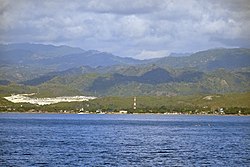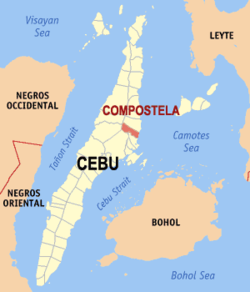Compostela, Cebu
Compostela | |
|---|---|
 Compostela skyline | |
 Map of Cebu with Compostela highlighted | |
| Country | Philippines |
| Region | Central Visayas (Region VII) |
| Province | Cebu |
| District | 5th district of Cebu |
| Founded Established | 26 December 1878 17 January 1919 |
| Barangay | 17 (see § Barangays) |
| Government | |
| • Type | Sangguniang Bayan |
| • Mayor | Joel Quiño (BAKUD) |
| • Vice mayor | Josephine Abing |
| • Municipal Council | Members |
| • Representative | Red Durano |
| Area | |
| • Total | 53.90 km2 (20.81 sq mi) |
| Population (2020 census)[3] | |
| • Total | 55,874 |
| • Density | 1,000/km2 (2,700/sq mi) |
| • Voter (2022)[4] | 36,622 |
| • Language | Cebuano Tagalog |
| Time zone | UTC+8 (PST) |
| ZIP code | 6003 |
| IDD : area code | +63 (0)32 |
| Income class | 3rd class (partly urban) |
| PSGC | 072218000 |
Compostela is a [[Template:PH plural of the Philippines#Income classification|3rd municipal income class municipality]] in the province of Cebu, Philippines.[2] According to the 2020 census, it has a population of 55,874.[3] Template:PH electorate
Compostela is within the Metro Cebu area.
History
In the year 1844, Spanish authorities established local government units on the northern part of Cebu starting from what is now known as the town of Compostela as far north as what is now called the town of Borbon. Compostela was among the early barrios of the Danao. The newly established barrio was named Compostela on the suggestion of a Roman Catholic friar who came from the town of Compostela in Spain and brought along with him the image of that town's patron saint, Santiago de Apostol. Adopting Senor Santiago de Apostol as the parish patron saint, a parish chapel was built from light materials. As the population grew, the Spanish church authorities decided to elevate the chapel into a church so that in the year 1866 the catholic church was constructed on the same site. Up to present time, the same structure continues to be the major place of worship in Compostela.
At the turn of the 20th century, the Americans gained control over the Philippines when they defeated the Spaniards in the Battle of Manila Bay. As a consequence, the Treaty of Paris caused the reorganization and reclassification of all local government units in the country according to their population and income. The reorganization which took place in 1903 resulted in the secession of Compostela to Liloan. In 1919, Compostela became a municipality.
World War II
| In 1942, the Japanese Imperial forces entered and occupied the town of Compostela.
During the Battle of Guila-Guila on 5 mar 1943, guerillas and male civilians organized as the soldiers and officers of the 8th Infantry Division of the Philippine Commonwealth Army and its subordinate units the several Infantry Regiments, Field Artillery Regiments and many others and supporting of the local troops and officers of the PCA 3rd, 8th, 82nd, 85th, 86th and 87th Infantry Division and the local Cebuano resistance groups fought the Japanese. This battle, commanded by Major Fabian Sanchez, resulted in numerous casualties to the Imperial Japanese Army led by General Sōsaku Suzuki. | ||||||||||||||||||||||||||||||||||
Barangays
Compostela comprises 17 barangays:[2]
| PSGC | Barangay | Population | ±% p.a. | |||
|---|---|---|---|---|---|---|
| 2020[3] | 2010[5] | |||||
| 072218001 | Bagalnga | 4.1% | 2,283 | 1,922 | 1.74% | |
| 072218002 | Basak | 3.2% | 1,773 | 1,695 | 0.45% | |
| 072218003 | Buluang | 2.4% | 1,365 | 1,259 | 0.81% | |
| 072218004 | Cabadiangan | 4.1% | 2,284 | 2,111 | 0.79% | |
| 072218005 | Cambayog | 2.3% | 1,283 | 1,165 | 0.97% | |
| 072218006 | Canamucan | 7.8% | 4,345 | 4,058 | 0.69% | |
| 072218007 | Cogon | 13.2% | 7,357 | 5,517 | 2.92% | |
| 072218008 | Dapdap | 2.2% | 1,212 | 1,151 | 0.52% | |
| 072218009 | Estaca | 11.3% | 6,327 | 5,177 | 2.03% | |
| 072218010 | Lupa | 1.6% | 873 | 812 | 0.73% | |
| 072218011 | Magay | 4.3% | 2,391 | 2,539 | −0.60% | |
| 072218012 | Mulao | 2.9% | 1,600 | 1,538 | 0.40% | |
| 072218013 | Panangban | 2.0% | 1,104 | 1,125 | −0.19% | |
| 072218014 | Poblacion | 18.6% | 10,372 | 9,536 | 0.84% | |
| 072218015 | Tag‑ube | 2.2% | 1,250 | 1,203 | 0.38% | |
| 072218016 | Tamiao | 2.7% | 1,533 | 1,225 | 2.27% | |
| 072218017 | Tubigan | 1.0% | 546 | 541 | 0.09% | |
| Total | 55,874 | 42,574 | 2.76% | |||
Demographics
|
| ||||||||||||||||||||||||||||||
| Source: Philippine Statistics Office[6][5][7] | |||||||||||||||||||||||||||||||
References
- ^ Municipality of Compostela | (DILG)
- ^ a b c "Municipal: Compostela, Cebu". PSGC Interactive. Quezon City, Philippines: Philippine Statistics Authority. Retrieved 8 January 2016.
- ^ a b c Census of Population (2020). "Region VII (Central Visayas)". Total Population by Province, City, Municipality and Barangay. Philippine Statistics Authority. Retrieved 8 July 2021.
- ^ "Number of Registered Voters by Sex : 2019 National and Local Elections" (PDF). Commission on Elections. 2019.
- ^ a b Census of Population and Housing (2010). "Region VII (Central Visayas)" (PDF). Total Population by Province, City, Municipality and Barangay. National Statistics Office. Retrieved 29 June 2016.
- ^ Census of Population (2015). "Region VII (Central Visayas)". Total Population by Province, City, Municipality and Barangay. Philippine Statistics Authority. Retrieved 20 June 2016.
- ^ Censuses of Population (1903–2007). "Region VII (Central Visayas)". Table 1. Population Enumerated in Various Censuses by Province/Highly Urbanized City: 1903 to 2007. National Statistics Office.
{{cite encyclopedia}}: CS1 maint: numeric names: authors list (link)
Sources
- Wagas, Neil Edwin R. (2014). "History of Compostela (Cebu, Philippines)". Archived from the original on 2016-08-22.
{{cite web}}: Invalid|ref=harv(help); Unknown parameter|deadurl=ignored (|url-status=suggested) (help)
